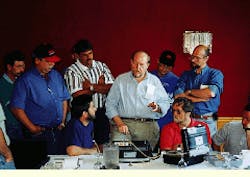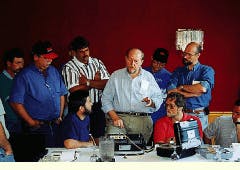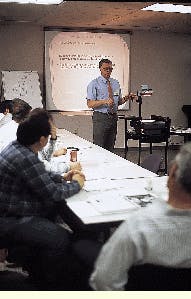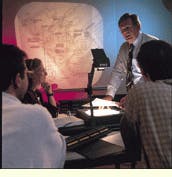Choose education and training to fit your needs
Barbara E. Thompson
The telecommunications industry is changing so rapidly that today we are dealing with equipment, standards, and technology that are different and more complex than just five years ago. Keeping up with these changes can be difficult, but one solution is to invest in your future with training and education--and this applies to everyone involved in designing, installing, and maintaining structured cabling system networks.
After determining who needs to receive training, you next have to decide what type of training or education you want, where it is available, and what it costs. As John Highhouse, program director for telecommunications training at Lincoln Trail College (Robinson, IL), explains, "Training is the hands-on part; education is the background and theory that make the hands-on understandable."
Training technology is constantly evolving, too. Traditional instructor-led training in formal classrooms and seminars is an excellent method and, in today`s electronic market, other options are also available: audio and video cassettes, interactive multimedia software for computer-based training (CBT), cd-roms, distance-learning, and, of course, the World Wide Web. Printed materials are also useful: books, manufacturer and distributor product literature and newsletters, home-study programs (also known as correspondence courses), trade magazines and newsletters, and professional organizations` newsletters. Professional societies can provide education through networking and, at conferences, you can attend seminars and visit exhibits to learn about new products and technology. And let`s not forget on-the-job training from seasoned technicians and registered communications distribution designers (rcdds), with whom you work side-by-side on a daily basis.
"I stay up-to-date on safety issues with news releases, outside publications and seminars," says Brian Kingman, safety officer at Consolidated Services Group Inc. (Norwood, MA). "I use the Internet more than I used to. For example, I spend time on the osha [Occupational Safety & Health Administration] home page to see what new changes, drafts, or fact sheets on safety topics are there."
In addition to the Internet, you may find information in buyers` guides, online databases and in calendar sections and advertisements in trade magazines. Many distributors and manufacturers have training facilities and on-the-road training as well: ADC Telecommunications, AMP Inc., Anixter, Graybar, Lucent Technologies, Ortronics, Siecor Corp., The Siemon Co., and 3M Telecom Systems Div., to name a few.
To ensure adequate training, review the format and content of any classes or materials you are considering. Some training covers only the highlights (which may be all you are looking for) but for more in-depth instruction, look for hands-on technical training as well.
Classroom provides focus
Formal classroom instruction is the most intense. Because you are usually away from your workplace and focused entirely on learning the topic, you will probably get the most from this type of education. Classes can run from two to five days, depending on the subject, and include instructor lectures with videos, student notebooks, and hands-on training.
Classes and seminars abound in the industry; therefore, check the abstract or call the provider with specific questions about what topics are covered. The longer and more detailed the course, the more expensive it will be. "In training, as in most cases, you get what you pay for," says Al Feaster, vice president of training and standards at Ortronics (Pawcatuck, CT).
Colleges such as Lincoln Trail College and Wentworth Institute (Worcester, MA) offer degree or technical-certificate programs for installers. In fact, according to Elias Awad, professor emeritus at Wentworth Institute and director of education for the Fiber Optic Association (FOA-Boston, MA), "There are more than 500 colleges in the United States teaching fiber-optic courses. The average course size is approximately 15, so that`s about 7500 students."
Classroom training is available from manufacturers, who offer installer certification, and from some distributors as well. Although some manufacturers and distributors offer training only for manufacturer-specific products, some provide "generic" training.
"Our purpose is to provide generic hands-on how-to-training: not a `dog-and-pony show` of products," says Feaster. "The industry has changed so rapidly, and many different people--electrical engineers and electrical contractors--want to learn how to pull telecommunications wire. The most important thing we can do is train those people generically. We need to ensure that customers are dealing with folks who know how to pull cable to industry standards."
Professional organizations
As the influx of people new to the telecommunications industry continues, the demand for technical instruction increases, so professional organizations offer training and education as well. For example, the FOA has a Certified Fiber Optic Technician training program, and Fotec Inc. (Medford, MA) has Fiber U classroom training, which is now also available as a correspondence course.
"Right now, there are probably twice as many people learning about fiber optics on the job as there were a couple of years ago," says Jim Hayes, president of Fotec and founder of the FOA. "That`s about 5000 to 10,000 people a year. In addition, many of these people who have completed the basic courses are now interested in advanced fiber optics courses." At Fiber U in Kansas City last year, Fiber U offered a hardware-oriented local area network course demonstrating how fiber and copper coexist. "This course was oversubscribed," says Hayes.
System designers, too, require training and re-education on new technologies and standards. As Paul Kreager of Level 0-1 Inc. (Pullman, WA) explains, "Today`s systems are more multidisciplinary. To create a good working design, you need to consider factors other than cable. You have to understand engineering fundamentals to reason out the proper design solutions."
Kreager says that two of the driving forces within our industry that tie into training and the need for correct design procedures are the standards of the Telecommunications Industry Association (TIA-Arlington, VA) and the nonprofit organization known as bicsi (Tampa, FL), with its registered communications distribution designer (rcdd) program. In addition to this rcdd program, bicsi now offers a LAN (local area network) program, and recently introduced its installation training and registration program at three levels: apprentice, installer, and technician.
"It`s important to get into the correct level of training with your peers," says Scott Smith, president, TeleTec Communications (Cape May, NJ) and a bicsi-certified instructor. "It can be frustrating for everyone if you do not have the same level of experience as others in the class."
Ed Phillips, president of Tel-Comm Contracting Inc. (Manchester, ME) and a bicsi-certified trainer, suggests that non-manufacturer-specific or generic training is best. "In our industry, we need to emphasize safety, grounding and bonding, firestopping, and standards."
Electronic training
In addition to traditional classroom training, several companies, such as The Light Brigade Inc. (Kent, WA), offer audio- and video-cassette training. Audios can be useful if you have to commute long distances or when you want to learn a new skill or brush up on safety or standards. "Audios work well with conceptual topics, such as wavelength-division multiplexing," says Larry Johnson, president. "Get a good speaker and script and make it innovative, and you can teach with audios. But to go into details, you need video to reinforce the teaching with graphics."
Videos offer the advantage of being able to show--close-up and hands-on--topics such as testing, cable preparation, termination, splicing, and power conditioning. In fact, many manufacturers offer videos on their products and how to install them; for example, Erico Inc., Sumitomo Electric Light Inc., Fluke Corp., and American Polywater.
Another way to work at your own pace is at the desktop. Interactive software, known as multimedia (voice, video, and text) CBT, is offered by some training organizations and a few manufacturers. In addition, you can purchase cd-roms, which are not interactive but can be used as a computer-based reference tool for such things as standards, safety issues and tips, and product directories.
This type of training can be used--and shared--by company employees to introduce new topics prior to formal training. With audios, videos, CBT, and cd-rom training, "You can learn what you want at your own pace and at your own site," says Johnson.
Distance-learning, which Johnson describes as "videoconferencing with a data circuit," is another relatively new form of training. Johnson says, "I expect that distance-learning will be a hot topic both for what it does to drive communications and as a training tool. Distance-learning can be used for specific disciplines--how to calibrate an odtr`s [optical time-domain reflectometer`s] index of refraction for accuracy--in a relatively short time, less than one hour."
Electronic training does have disadvantages, however. "In our industry the standards change so rapidly," says Ortronics` Feaster. "About the time the information is put together in a video or CBT program, it is outdated." However, Johnson says The Light Brigade updates its videos and includes new technology products every two years on each fiber-optic topic.
The disadvantage of any type of electronic training, however, is that the instructor is not in the same room with the student, and the student cannot benefit from sharing knowledge with others in the class. "Electronic training may be all right for basic training," says Phillips, "but you also need feedback from the instructor and peers, as well as the hands-on training. In class, you get to do it until it`s right." Most of the trainers and contractors interviewed agreed that they did not know of any type of training that can beat hands-on training.
On-the-job training
Learning from others is another form of education; for example, on-the-job training (OJT). As mentioned, bicsi offers a structured OJT program for its installer registration program. bicsi trainer Phillips offers one piece of advice, however, "We tell our students not to accept something because `that`s the way we`ve always done it,` but to ask why."
The Light Brigade also has an OJT program performed by its technical services group. "An electrical contractor company, basically tooled in multimode fiber, wants to do a singlemode project," explains Johnson, "and suddenly realizes that its 850-nanometer otdr is not going to work on singlemode fiber. The contractor can bring us in to teach its employees how to perform the tasks, and supply the otdr and fusion splicer, too. In essence, they get actual field training and the expertise without spending capital funding."
You can also offer training by experienced technicians at your office or the job site. "We run in-house safety training two or three nights a week," says Kingman. "We also have a `newsletter` that goes out on the back of payroll checks dedicated strictly to safety."
Many good books have been published on telecommunications topics such as designing and installing premises cabling, fiber optics, cable testing, troubleshooting, network management, wireless, small office/home office, several "Back to Basics" books, and books for "dummies." Several training organizations publish catalogs of books relating to the industry, and Cabling Installation & Maintenance has a "By the Book" section that describes new books for the telecommunications industry (see page 60).
Standards and technical manuals published by professional organizations are another good reference source for your company library. Examples include the National Electrical Code published by the National Fire Protection Association (Quincy, MA); standards from the Telecommunications Industry Association/Electronic Industries Association (Arlington, VA); and the bicsi (Tampa, FL) Telecommunications Distribution Methods Manual and LAN Design Manual for system designers, and the Cabling Installation Manual.
Also, most professional organizations have newsletters to keep members informed on the latest technology changes in the industry; for example, bicsi, the FOA, Independent Electrical Contractors Inc. (Alexandria, VA), the International Brotherhood of Electrical Workers (Washington, DC), the InterNational Electrical Contractors Association (Bethesda, MD), and the New England Fiber Optic Council (Chestnut Hill, MA). Trade magazines, journals, and directories are yet another source of education and training in print media, some of which are also published on the Web.
In addition, many organizations hold conferences and expositions that include technical sessions as well as exhibits. If you cannot attend, many organizations offer printed copies of the sessions with a wealth of up-to-date information to share with your co-workers.
The last consideration is cost. Basically, three elements make up the cost of training: the direct cost of the course, the cost of any travel-related expense, and the time you are away from your work. "Ensure that the course provides a value, or return on investment," says Johnson. That return may be increased productivity, broader knowledge, or new ways to solve problems and bring about a more efficient and cost-effective way to design and install cable systems.
Jim Hayes, president of Fotec Inc. (Medford, MA), teaches hands-on fiber-optic testing.
Paul Kreager, rcdd, president of Level 0-1 Inc. (Pullman, WA), conducts a system design training session at the United States Military Academy (West Point, NY).
Al Feaster, rcdd, vice president of training and standards at Ortronics, develops and teaches classes for internal and external training.



